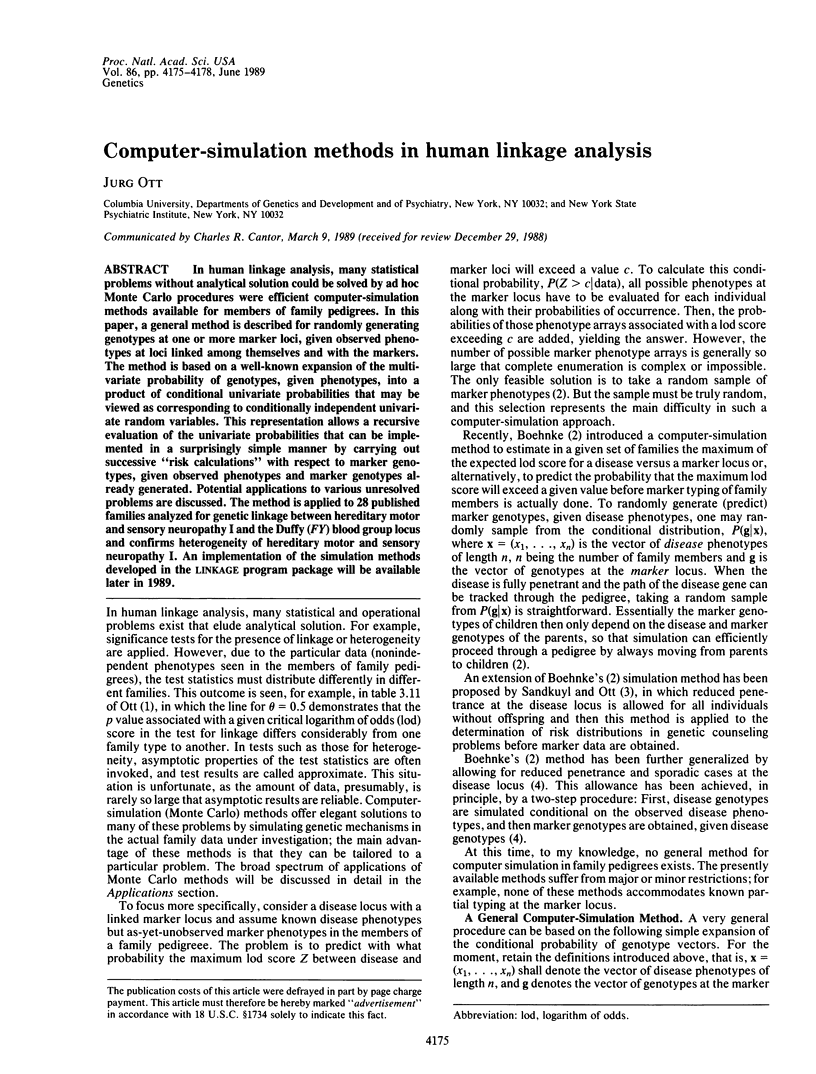Computer-simulation methods in human linkage analysis (original) (raw)
Abstract
In human linkage analysis, many statistical problems without analytical solution could be solved by ad hoc Monte Carlo procedures were efficient computer-simulation methods available for members of family pedigrees. In this paper, a general method is described for randomly generating genotypes at one or more marker loci, given observed phenotypes at loci linked among themselves and with the markers. The method is based on a well-known expansion of the multivariate probability of genotypes, given phenotypes, into a product of conditional univariate probabilities that may be viewed as corresponding to conditionally independent univariate random variables. This representation allows a recursive evaluation of the univariate probabilities that can be implemented in a surprisingly simple manner by carrying out successive "risk calculations" with respect to marker genotypes, given observed phenotypes and marker genotypes already generated. Potential applications to various unresolved problems are discussed. The method is applied to 28 published families analyzed for genetic linkage between hereditary motor and sensory neuropathy I and the Duffy (FY) blood group locus and confirms heterogeneity of hereditary motor and sensory neuropathy I. An implementation of the simulation methods developed in the LINKAGE program package will be available later in 1989.

Selected References
These references are in PubMed. This may not be the complete list of references from this article.
- Bishop D. T. The information content of phase-known matings for ordering genetic loci. Genet Epidemiol. 1985;2(4):349–361. doi: 10.1002/gepi.1370020404. [DOI] [PubMed] [Google Scholar]
- Boehnke M. Estimating the power of a proposed linkage study: a practical computer simulation approach. Am J Hum Genet. 1986 Oct;39(4):513–527. [PMC free article] [PubMed] [Google Scholar]
- Lathrop G. M., Chotai J., Ott J., Lalouel J. M. Tests of gene order from three-locus linkage data. Ann Hum Genet. 1987 Jul;51(Pt 3):235–249. doi: 10.1111/j.1469-1809.1987.tb00876.x. [DOI] [PubMed] [Google Scholar]
- Lathrop G. M., Lalouel J. M. Efficient computations in multilocus linkage analysis. Am J Hum Genet. 1988 Mar;42(3):498–505. [PMC free article] [PubMed] [Google Scholar]
- Middleton-Price H. R., Harding A. E., Berciano J., Pastor J. M., Huson S. M., Malcolm S. Absence of linkage of hereditary motor and sensory neuropathy type I to chromosome 1 markers. Genomics. 1989 Feb;4(2):192–197. doi: 10.1016/0888-7543(89)90299-1. [DOI] [PubMed] [Google Scholar]
- Ott J., Lathrop G. M. Goodness-of-fit tests for locus order in three-point mapping. Genet Epidemiol. 1987;4(1):51–57. doi: 10.1002/gepi.1370040107. [DOI] [PubMed] [Google Scholar]
- Ploughman L. M., Boehnke M. Estimating the power of a proposed linkage study for a complex genetic trait. Am J Hum Genet. 1989 Apr;44(4):543–551. [PMC free article] [PubMed] [Google Scholar]